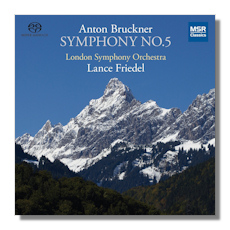
The Internet's Premier Classical Music Source
Related Links
- Bruckner Reviews
- Latest Reviews
- More Reviews
-
By Composer
-
Collections
DVD & Blu-ray
Books
Concert Reviews
Articles/Interviews
Software
Audio
Search Amazon
Recommended Links
Site News
 CD Review
CD Review
Anton Bruckner

Symphony #5 (ed. Nowak)
London Symphony Orchestra/Lance Friedel
MSR Classics SACD 1600 73:19 Hybrid Multichannel
The observation has often been made that Anton Bruckner, a very accomplished organist, wrote what was essentially organ music that he orchestrated and then called a symphony. While I think that notion is a bit of an exaggeration, the Fifth Symphony may be the best example to support the case. It has so many passages of sostenuto writing, as well as crescendos and diminuendos and the like. Plainly, it seems as if the orchestra is so often holding onto notes or that the music is forever swelling and receding. You can almost imagine an effective organ performance of the work. Looking at the work this way, one might observe that the trick to conducting a convincing performance of the piece is to bring out the colorful character of the orchestration, allowing individual instruments and groups of instruments in proper balance to delineate the complexities in the score rather than to create huge washes of sound that can muddy the waters and blur detail.
American conductor Lance Friedel opens your eyes and ears to the complexities in the score. He offers a multi-faceted take on the work, sometimes seeming scaled down, other times sounding enormous and bold. He allows you to hear all sorts of meaningful detail while not sacrificing the epic sense of this Bruckner symphony. Certain conductors descend into bombast, or make the "swelling and receding" aspects sound monotonous or tiresome. Friedel knows how to shape the score and always seems to select a workable tempo: try his rather lively pacing from 2:51 in the finale and notice how the music intensifies especially from 3:25 when those yearning, swirling strings ratchet up the tension so passionately. Take note too of how he clearly and subtly points up the plentiful contrapuntal activity in the finale, as well as throughout the symphony.
The first movement never drags and is filled with mystery, tension and ecstatic triumph. Previously, this was sometimes a tough movement for me to weather, as it seemed to bog down in places. But here in Friedel's hands it is vital, spirited and fresh sounding. The equally lengthy Adagio that ensues doesn't come across as overlong, as it can in other performances. Once again, Friedel imparts a vigor and robustness to the flow of the music, but without pushing the tempo ahead unreasonably or shortchanging the more tender and gentler moments. Slight shifts in pacing are well managed and subtle, giving a natural and seamless flow to the music. In this performance, you're always aware that something is happening on and beneath the surface. The Scherzo is lively and playful but also a bit menacing, as it should be.
In the end, one must observe that Friedel draws excellent performances in all four movements from the LSO, an orchestra known for its on-and-off days. To those who might find Bruckner a long-winded, sometimes vexing composer, this performance, better than any other in recent memory, may well change their view. Past recordings of the Fifth by Barenboim and Tintner failed to completely convince me of this work's greatness. Thus, to me this symphony has always been at least a bit iffy, but the more I listened to this performance by the LSO under Friedel, the more my opinion of the work grew. Yes, it's a Bruckner masterpiece to rank with Nos. 7, 8 and 9.
By now, many readers are probably wondering, just who is Lance Friedel? Well, he's held posts as music director of the Providence Chamber Orchestra and as assistant conductor of the Peabody Symphony Orchestra. He has also made recordings for Naxos and MSR Classics featuring works by Nielsen, Foerster and others. He has conducted throughout the US and in Europe, and is obviously a huge talent, if I can judge from this recording. Some major orchestra should sign him to a long-term contract. He appears to be the real thing, a conductor who knows precisely how to draw out the performance he imagines from the orchestra – and what he imagines is quite special indeed. The sound reproduction on this MSR Classics SACD is vivid and powerful. Highly recommended.
Copyright © 2016, Robert Cummings



















